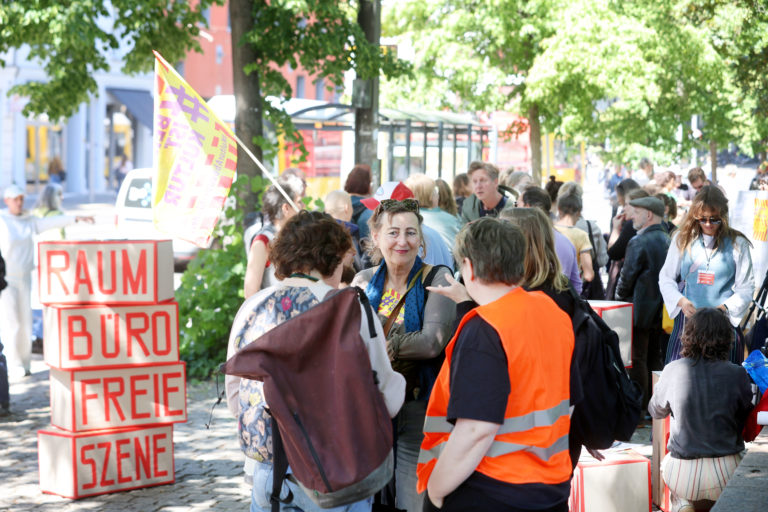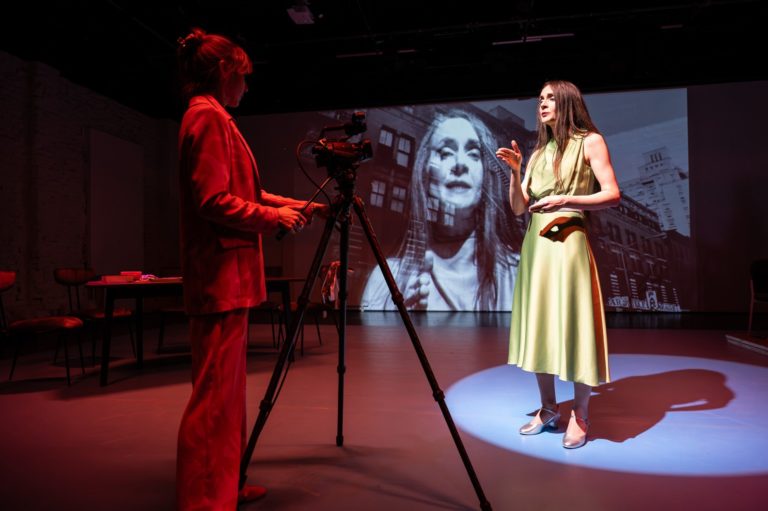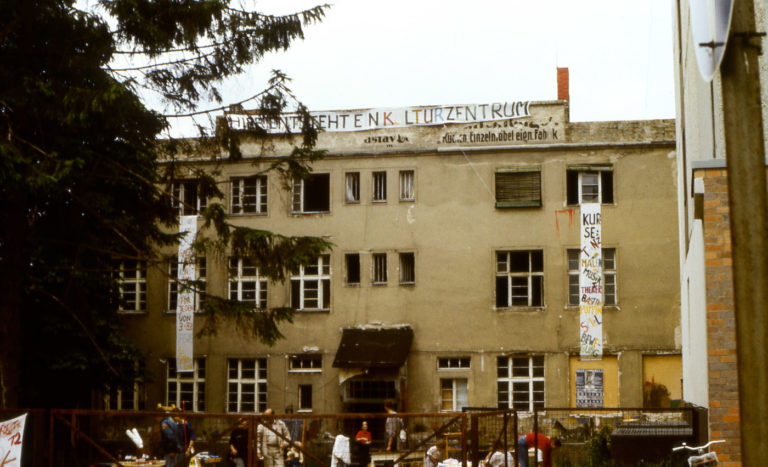This article is part of Reset! Yearly Focus 2025: Reclaiming Spaces
Author: Josephine Böllhoff
Berlin’s cultural landscape is under pressure. As the city senate pushes ahead with deep budget cuts, theatres, artists, and independent organisations face an uncertain future. For a city that has long branded itself as “poor but sexy,” the stakes are more than financial—they touch the very identity that draws millions of visitors and sustains the livelihoods of one in ten Berliners working in the cultural sector.

Artists protest against shrinking workspaces during the #KulturbrauchtRaum action day in May 2025 — © Christian von Polentz
In November 2024, the Berlin senate announced substantial budget cuts for the next year, across all sectors. For the city’s cultural actors who have been struggling against rising costs and whose share in Berlin’s overall budget remains on the lower end of all sectors, the cuts equivalent to 12.5%, an amount worth 133 million euros, are threatening. At stake are valued programmes, livelihoods—and Berlin’s indispensable cultural diversity at large.
The struggle for space—both in the financial and the literal sense—continues as the budget negotiations for the years 2026/2027 are in full swing. “Spending on culture now makes up less than 2% of the entire city’s budget,” says Janina Benduski, co-initiator of Berlin ist Kultur (BiK), a protest and advocacy alliance which was launched after the 2025 funding cuts were first announced. According to the initiative’s latest press release, this marks an all-time low budget share for cultural actors in the city. The arts and culture will lose between 90 and 140 million euros per year, going forward. “Even though the cuts are less than originally announced,” says Benduski, referring to the fact that up until June, cultural actors were fearing cuts up to 160 million euros, “this is nowhere near what a cultural city like Berlin needs.” Benduski has been an active advocate for Berlin’s Freie Szene (‘independent culture and arts scene’) as Programme Director and co-opted member of The Berlin State Association for the Independent Performing Arts (LAFT Berlin). “If you think about the fact that culture has already been underfunded and that the people in the cultural sector already work in precarious conditions, you wonder how it can be justified to cut any funding at all.”
In Berlin, a city where 10% of the working population work in the cultural and creative sectors, and where 61% of 2023-2024 visitors came to the city for its culture and arts, the budget share for culture seems disproportionate to the role it plays for inhabitants and visitors alike. “Actually, the funding should have been stocked up, given the rise in costs and inflation. This hasn’t happened in a long time and as a result, I think, we’ll see an even more shrinking cultural scene in Berlin.” The frustration about the stagnating budget proportion for the arts and culture was fuelled when, in July 2025, the senate decided to increase its overall budget by 3.1 billion euros in 2026, but this was not reflected in the ‘Culture and Social Cohesion’ budget.

Scene from "Pop! Andy Warhol & The Velvet Underground" at the English Theatre — © Stefania Migliorati
Shrinking Space for Culture and Arts
Since the beginning of the year, the funding cuts for 2025 have already shown their effects for some. Among other larger theatres in the city, the Schaubühne am Lehniner Platz was forced to take measures to accommodate the gap in funding. “In January, we had to close down our ‘studio’, our venue for young directors,” says Nils Haarmann, dramaturg at the Schaubühne. “We also couldn’t realise some of the productions planned and had to significantly elevate the prices in our upper segments—for longstanding, and successfully running productions.” The Schaubühne is one of Berlin’s State-funded and privately-operated theatres with steady budget positions within the “Culture and Social Cohesion” budget. In November 2024, Schaubühne warned in a press release that they might face bankruptcy by the end of 2025, with the funding cuts originally announced. In December 2024, the cuts were reduced after loud protests, leaving the Schaubühne with 1 million euros in funding cuts instead of 1.8 million.
Three theatres in the independent performing arts sector, on the other hand—which were largely sheltered from direct funding cuts in 2025—are now at risk of disappearing from the cultural scene altogether. In July, the English Theatre – International Performing Arts Centre, the Fliegendes Theater, and Schlossplatztheater found that they had been left off the list of candidates for the so-called “basic funding for production venues.” The two-year funding scheme from the senate helps performance venues that do not have a permanent place in the budget to sustain their daily operations. “I suspect this has a great deal to do with the inadequate amount of funding available for the large independent performing arts landscape in the state of Berlin,” says Daniel Brunet, Producing Art Director at the English Theatre, a small independent performing arts theatre in the Kreuzberg district. “The programmes are oversubscribed in the sense that they receive applications going into the tens of millions of euros and do not have that sum available to give out.” The commentaries, usually published by the commissioning juries (this year a comment is still lacking), point in the same direction: “The gap between the funding needs and budget are the largest we have ever seen in this round,” wrote the jury with regard to the 2024/2025 production venue round. For the English Theatre, which was recommended in 2023 to move up into a four-year funding scheme and has been called an “indispensable production venue for independent performing groups and artists from Berlin and beyond,” the information came particularly surprising.
None of the theatres—all of them successful candidates on the production venue grant for years—had received a prior notice of the results. “We were indirectly informed about this through a press release by the senate,” says Peggy Anders, press officer of the Fliegendes Theater. During the last funding period, the grant paid for about a third of the educational theatre’s entire expenses. “We immediately issued a cry for help to the Board of Division [of the senate] and stated clearly that this would mean the end for us.” The same fate threatens the Schlossplatztheater in Berlin Treptow-Köpenick—a legacy institution in the south-east of Berlin. In the district of roughly 300,000 on the outer edges of Berlin, the theatre is the only one of its kind, offering both educational productions and programmes for children and youth, as well as a space for independent performing groups. Founded in 1995 out of the squatting of the so-called “Alte Möbelfabrik” five years earlier, the theatre also carries a significant historical meaning. Birgit Grimm, Artistic Director of the Schlossplatztheater, has been with the theatre from the very beginning. “I was one of the squatters in the factory and built up the theatre for 35 years,” she remembers. “This is my life’s work.” Determined to keep it running, she launched a call for supporters to advocate for the historic venue and is herself actively fighting for the theatre. “If we disappear, an important part of the infrastructure for independent performing artists disappears, too.”

The "Alte Möbelfabrik" in 1990 — © Archive Alte Möbelfabrik e.V./Schlossplatztheater
Workspaces at Risk
With rising rent costs, visual and performative artists largely depend on affordable atelier and rehearsal spaces. The so-called Arbeitsraumprogramm (ARP) (‘workspaces programme’), a senate-funded programme providing subsidised workplaces for independent artists across disciplines, has served as an important infrastructure for many since 2016. And yet, in light of the funding cuts, also the ARP is crumbling. Despite a commitment by the senate to the programme, its budget was reduced by 23 million euros in 2024, reports the Koalition der Freien Szene e.V.. According to Brunet, the speaker for the performing arts at the Koalition der Freien Szene, further cuts to the ARP are expected but the extent remains unclear. For both visual and performative artists these cuts are fatal. “If you're rehearsing in spaces where you can't mock up your set, mock up your lights, your sound, your projections, your costumes, it's very, very, very difficult to do good work,” explains Brunet who is well-accustomed with the needs of performing artists. In a survey, conducted by the Koalition Freie Szene and its Raumbüro Freie Szene between June and July 2025, 67.5% of respondents said the current supply of working spaces is insufficient. 50% of respondents rated their own work situation as critical.
Cultural Actors Are Reclaiming Space
While the past year has left many in the arts and culture breathless, it has not left them speechless. Since its initiation in November 2024, Berlin ist Kultur provided a platform for cultural actors, from established theatres and museums to the city’s entire and unique Freie Szene, to come together and collectively organise. Since then, the alliance has organised many actions aimed at making their community’s voices heard—from a protest concert hosted in December 2024 at the Haus der Berliner Festspiele, to petitions, open letters, and weekly Friday meetings. On May 21st, 2025, visual and performing artists got together at Brunnenstraße for a protest under the theme of #KulturbrauchtRaum (“culture needs space”) to demonstrate for their right to workspaces in the city. They set a sign against the cuts by temporarily relocating their workplaces onto the street. On September 27th, 2025, a big Protest-Fest for Culture, Social Work, and Science to highlight the importance of a socially and culturally diverse city is still in planning. “All these things are equally important, and all these things go into having a city that's worth living in,” says Daniel Brunet.
Amid everything, Berlin’s culture and arts community is continuing to be both determined and hopeful. “Overall I have to say that the protests were successful. It’s noticeable that both politicians and the public have understood that culture can’t just sustain itself but that it needs support,” says Benduski who feels that the solidarity in the community has proven effective. Grimm, who is meanwhile unsure of the future of her theatre, is grateful for support and solidarity coming from different sides. “Many people in the right places are fighting for us.” Haarmann, too, says the main difference to the previous budget negotiations is that political actors are now reacting to the concerns of cultural actors in Berlin and that a dialogue seems possible. And both the English Theatre and the Fliegende Theater are waiting to hear from the senate whether they can at least get funding for one year. They will only learn in December 2025, whether their theatres will survive another year or whether they will be left without funds just days after the decision.
Published on September 23rd, 2025
About the author:
Josephine Böllhoff is a media freelancer based in Berlin, Germany. For the past two years, she has worked as a Production and Communications Editor with the non-profit media, Are We Europe. This year, she started focusing more on journalistic writing, with a primary interest in social issues, culture, and politics. Josephine holds a bachelor’s degree in Liberal Arts and Sciences from Amsterdam University College and a master’s in Sociology from the University of Bielefeld.